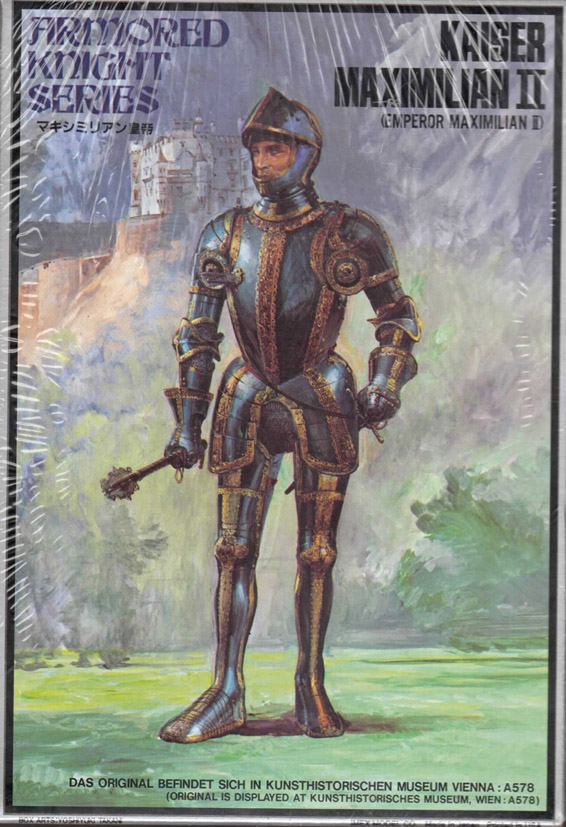
Saturday, 19 February 2011
my collection . maximillian armour

I was walking in vicenza in 1980 when i came across an old toy shop and bought a bunch of gthese old britains for pence.I photographed this with a hundred pound sony cybershot.
Maximilian armour is a modern term applied to the style of early 16th century German plate armour apparently first made for the Emperor Maximilian I. The armour is characterized by armets and close helmets with bellows visors, small fan-shaped narrow and parallel fluting often covering most of the harness (but never the greaves), etching, work taken from woodcuts and sharply waisted cuirasses and squared sabatons.
Maximilian armour is a modern term applied to the style of early 16th century German plate armour apparently first made for the Emperor Maximilian I. The armour is characterized by armets and close helmets with bellows visors, small fan-shaped narrow and parallel fluting often covering most of the harness (but never the greaves), etching, work taken from woodcuts and sharply waisted cuirasses and squared sabatons.
According to an alternative version the name is related with Maximilian II as the last Maximilian Armour was made especially for him in 1557 - 17 years after it passed out of use (according to Liliane Funcken & Fred Funcken[1] it passed out of use in 1540, but the last one was made for Maximilian II).

The armour itself was designed to imitate the pleated clothing that was considered fashionable in Europe at the time. This was a trend that was developing in 15th century Europe of creating armour that not only provided the maximum amount of protection, but was also visually pleasing. It combined the rounded Italian style of rounded armour production with the German fluted style.
lone star and crescent indians
He was 31 years old, and a Sepoy in the 6th battalion in the 13th frontier force, in the indian armywhen the following deed took place for which he was awarded the VC.
On 9 April 1945 near Fusignano, Italy, at the start of the Allied spring 1945 offensive Haidar's battalion was tasked with a difficult assault crossing of the Senio River. Only Sepoy Ali Haidar and the two other men of his section managed to get across under heavy machine-gun fire.
Then, while the other two covered him, the sepoy attacked the nearest strong point and, in spite of being wounded, put it out of action. In attacking a second strong-point he was again severely wounded but managed to crawl closer, throw a grenade and charge the post; two of the enemy were wounded, the remaining two surrendered. The rest of the company were than able to cross the river and establish a bridgehead
On 9 April 1945 near Fusignano, Italy, at the start of the Allied spring 1945 offensive Haidar's battalion was tasked with a difficult assault crossing of the Senio River. Only Sepoy Ali Haidar and the two other men of his section managed to get across under heavy machine-gun fire.
Then, while the other two covered him, the sepoy attacked the nearest strong point and, in spite of being wounded, put it out of action. In attacking a second strong-point he was again severely wounded but managed to crawl closer, throw a grenade and charge the post; two of the enemy were wounded, the remaining two surrendered. The rest of the company were than able to cross the river and establish a bridgehead
Friday, 18 February 2011
dieppe
 The Dieppe Raid, also known as The Battle of Dieppe, Operation Rutter or later on Operation Jubilee, during the Second World War, was an Allied attack on the German-occupied port of Dieppe on the northern coast of France on 19 August 1942.
The Dieppe Raid, also known as The Battle of Dieppe, Operation Rutter or later on Operation Jubilee, during the Second World War, was an Allied attack on the German-occupied port of Dieppe on the northern coast of France on 19 August 1942. The assault began at 5:00 AM and by 10:50 AM the Allied commanders had been forced to call a retreat. Over 6,000 infantrymen, predominantly Canadian, were supported by large Royal Navy and Royal Air Force contingents.
The assault began at 5:00 AM and by 10:50 AM the Allied commanders had been forced to call a retreat. Over 6,000 infantrymen, predominantly Canadian, were supported by large Royal Navy and Royal Air Force contingents. The objective was to seize and hold a major port for a short period, both to prove it was possible and to gather intelligence from prisoners and captured materials while assessing the German responses. The Allies also wanted to destroy coastal defences, port structures and all strategic buildings.
The objective was to seize and hold a major port for a short period, both to prove it was possible and to gather intelligence from prisoners and captured materials while assessing the German responses. The Allies also wanted to destroy coastal defences, port structures and all strategic buildings.
No major objectives of the raid were accomplished. A total of 3,623 of the 6,086 men (almost 60%) who made it ashore were either killed, wounded, or captured. The air force failed to lure the Luftwaffe into open battle, losing 96 aircraft (at least 32 to Flak or accidents) c
 ompared to 48 lost by the Luftwaffe, while the Royal Navy lost 33 landing craft and one destroyer. The events at Dieppe later influenced preparations for the North African (Operation Torch) and Normandy Landings (Operation Overlord).
ompared to 48 lost by the Luftwaffe, while the Royal Navy lost 33 landing craft and one destroyer. The events at Dieppe later influenced preparations for the North African (Operation Torch) and Normandy Landings (Operation Overlord).
Wednesday, 16 February 2011
Sunday, 13 February 2011
Subscribe to:
Comments (Atom)









